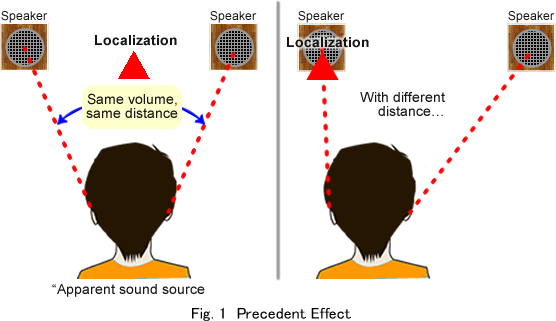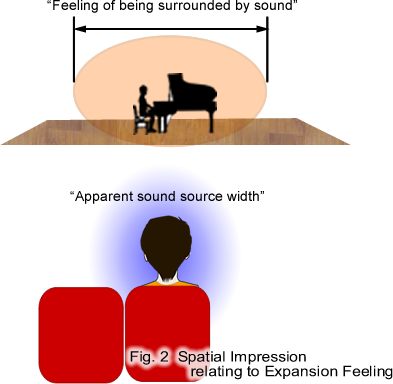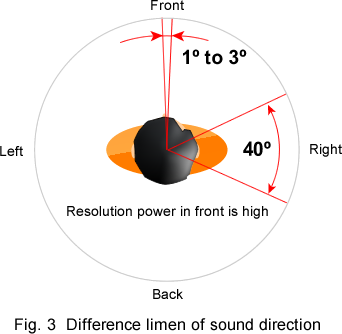- HOME
- Ono Sokki's Patio
- Binaural Effect

Binaural Effect
Dad: Today we will talk about the binaural effect we mentioned before.
Ken: You taught me about the delay for a sound to arrive to both ears and how head shape is related. Also, if you are at equal distance from two stereo speakers, the sound is localized in the center, but if you come close to either speaker, it is localized to that speaker.
Dad: It can be said that if there are multiple sources of a sound, perceiving the source from the sound that arrives first as the only sound source is "precedence effect", and localizing that sound source is "binaural effect". (Figure.1) The spread of sound is sensed because you have ears at on both sides of your head, and this is also referred to as a binaural effect.

Ken: Is the echoing at a concert hall a "spread of sound"?
Dad: You can sense the echoing with one ear covered, right?
This is going to be technical but it is said that there are
two types of perception to the "spread of sound". One is the
"feeling of being surrounded by sound", and this is closer
to the "spread of sound" concept. The other feeling is the
sound source itself expanding, which is called "apparent
sound source width". For both, depending on the composition
(direction, time, and level) of the reflected sound that
comes after the actual sound, the intensity is different.
(Figure.2)
Ken: This seems difficult. It is easy to imagine that we are able to tell the sound direction since we have ears on both sides.
Dad: That is true. Then let’s think about it in a room that doesn’t echo (anechoic room) with one sound source. When the sound comes from right in front, there are no delay times when the sound wave arrives to both ear, so you perceive the sound source in right in front. But if it's from right behind, it also has no time delay, so it is not rare to mistake a sound coming from behind to feeling it from the front.
Ken: Really? I never experienced perceiving a sound from the front, which actually came from behind.
Dad: In a normal room, other than the sound from behind, reflection sound from the walls and ceilings also give you information. Another reason is sound usually has a meaning to it, so as soon as you hear a sound, you conclude what sound it is and from which direction it should come in from the surrounding environment.
Ken: The experiment in a room without reflection sound from walls and ceilings and other information is not a situation you experience normally.
Dad: That is true. But you have to eliminate uncertain factors in these types of experiment and make it simple or you cannot obtain the truth. We need to explain what is happening in the real environment by integrating each fact from every experiment.
Ken: I see. How about anywhere but the front?.
Dad: Let me continue. What angle do you think people distinguish the direction of sound?
Ken: I am not sure, but about 10 degrees?
Dad: Actually, for direction from the front, there are differences depending on frequency but people can perceive the directional difference of about 1 to 3 degrees. This is quite impressive, because the time difference for the sound to reach both ears is about 1/100,000 second. (10 microseconds)
Ken: I am surprised that you can differentiate at such acute angles. What happens if it’s not from the front?
Dad: If it’s about 60 degrees to the side from the front, the
accuracy of direction localization falls; you can only sense
a range of about 40 degrees if sound comes from the side.
(Figure.3)
Ken: Front and the side can have that much of a difference?
Dad: That is because there is a big difference between the head-related transfer functions of the left and right ears when the sound is from the side. Due to this, the left and right time difference when the input angle differs becomes smaller compared with the case when it comes from the front. And another is when people try to confirm the sound; they face in that direction, so maybe that is why the sensitivity in front is naturally higher. I only mentioned about time delay but important aspects to determine sound direction is both time delay and sound pressure difference.
Ken: Is there a difference in sound pressure because diffraction is different between left and right?
Dad: Yes. Both aspects are related to frequency, and it is said that the time delay is effective when the frequency is 1500Hz or less and the sound pressure difference is effective when it is over 1500Hz.
Ken: It is confusing. It seems necessary to gradually explicate in an anechoic room.
Dad: Yes. I previously talked about the cocktail party effect. Sound localization with both ears also contributes to that selective hearing. Research of the sound localization can be applied to various fields, such as robotic engineering.
- © ONO SOKKI CO., LTD. 1996-2025
